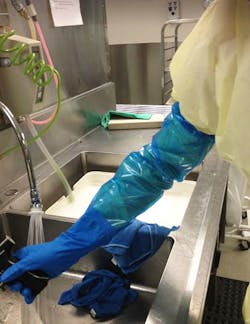Q
I saw a staff member donning his gloves for work in decontamination not wash his hands. Is this the correct practice?
A
As with any practice, and especially with gloves, facilities should have a standard way of donning gloves at their facility based on standards, guidelines and the glove manufacturers’ instructions for use (IFU). There are a set of “Best Practice Common Steps” that should always be followed no matter where you are donning gloves.
1. Wash hands with soap and water for 20 seconds before putting on gloves.
2. Close the proper glove for the task at hand from the inventory provided.
a. Wear properly fitting gloves with a close fit around fingers and wrists to reduce the risk of exposure.
b. If wearing any type of gown, make sure the gloves extend at least over the cuff of the gown.
3. Never reuse or wash single-use or exam gloves.
4. Never use damaged or visibly soiled gloves.
5. Do not touch your face while wearing gloves.
So, from the information in your question, I would say yes, the person did not follow this best practice for donning gloves.
Q
Is there a thickness that gloves need to be for working in decontamination?
A
The type of glove that a staff member uses should be based on the type of procedure to be performed (e.g., surgical versus nonsurgical or housekeeping procedures). Medical-grade nonsterile examination gloves and sterile surgical gloves are medical devices regulated by the U.S. Food and Drug Administration (FDA). The FDA does not regulate general-purpose utility gloves because they are not promoted for medical use. Sterile surgical gloves must meet standards for sterility assurance established by the FDA and are less likely than nonsterile examination gloves to harbor pathogens that may contaminate an operative wound.
When we review information in ANSI/AAMI ST79, it does not get specific with a stated thickness. The standard instead gives characteristics that gloves should have for working in decontamination. The term for this type of glove is a utility glove. Utility gloves should be fitted at the wrist, prevent contact of the wearer’s skin with contaminated water, and have cuffs that extend beyond the gown’s cuff. It also states that a medical examination glove should not be used in decontamination, as it is not puncture- or cut-resistant. I would suggest that the facility decide on glove thickness by performing a risk assessment. Consider things like the type of tasks staff perform, how dexterous people need to be, and the risk of exposure to help decide on the thickness of gloves.
With Occupational Safety and Health Administration (OSHA), we find the following statements backing up the assessment approach to selecting adequate glove thickness and design.
• 1910.138(a) - General requirements. Employers shall select and require employees to use appropriate hand protection when employees’ hands are exposed to hazards such as skin absorption of harmful substances; severe cuts or lacerations; severe abrasions; punctures; chemical burns; thermal burns; and harmful temperature extremes.
• 1910.138(b) Section. Employees shall base the selection of the appropriate hand protection on evaluating the performance characteristics of the hand protection relative to the task(s) to be performed, conditions present, duration of use, and the hazards and potential hazards identified.
Gloves, depending on how they are used in medical facilities, have various standards and tests that they need to comply with. Some of them are from the American National Standards Institute (ANSI), which provides a guideline for the selection of hand protection (ANSI/ISEA 105). This guideline gives manufacturers a mechanism to classify their products for specified areas of glove performance. The following American Society for Testing and Materials (ASTM) guidelines also address glove usage.
• ASTM D5151, Test Method for Detection of Holes in Medical Gloves
• ASTM F1671, Test method to show gloves’ ability to protect against microorganisms.
• ASTM F1790, Standard Test Method for Measuring Cut Resistance of Materials Used in Protective Clothing
Thus, facilities should perform a proper risk assessment and involve the staff who will be using the gloves. By doing that, I feel a policy can be implemented to address all the concerns of the proper glove to be used in the decontamination area, including its thickness.
Note: Glove thickness is stated in either mils or gauge. A 10-gauge glove equals 10 mils or 0.010 inches. When choosing your glove, look for the stated thickness on the manufacturer’s test data.
References
2. https://www.osha.gov/laws-regs/regulations/standardnumber/1910/1910.138
About the Author

Stephen M. Kovach
Stephen M Kovach, BS, CFER, started in the medical field in 1975 as a sterilization orderly and has worked in many positions within the Healthcare Industry. He presently is Clinical Educator Emeritus at Healthmark, A Getinge company.

